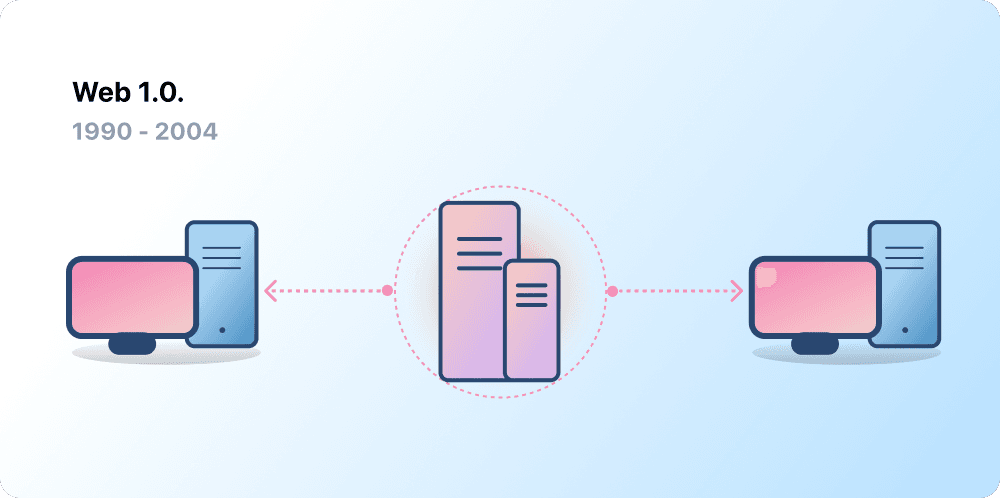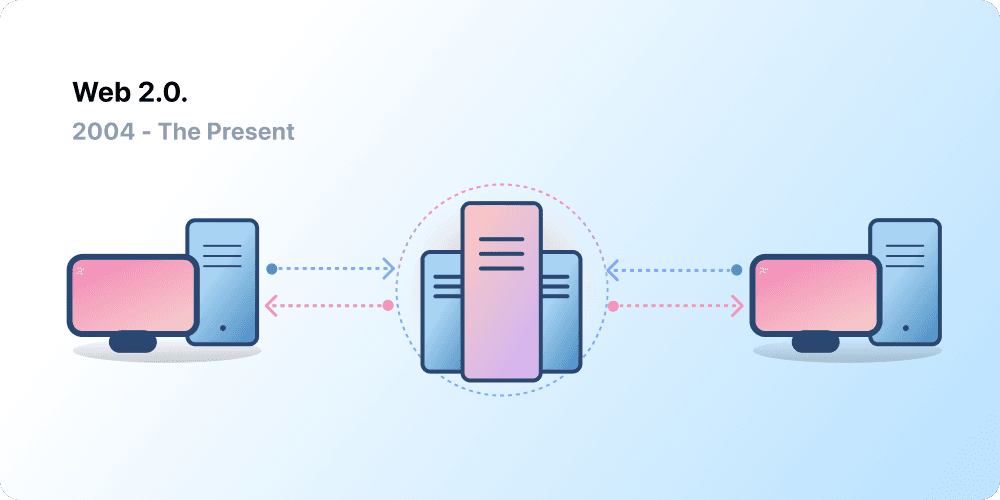Εισαγωγή στο Web3
Η κεντρική διαχείριση έχει βοηθήσει δισεκατομμύρια ανθρώπους να αποκτήσουν πρόσβαση στον Παγκόσμιο Ιστό, δημιουργώντας μια σταθερή και ισχυρή δομή στην οποία και λειτουργεί. Την ίδια στιγμή, μια μερίδα κεντρικών οργανισμών κατέχουν το μεγαλύτερο τμήμα του Παγκόσμιου Ιστού, αποφασίζοντας μονομερώς τι επιτρέπεται και τι όχι.
Η απάντηση σε αυτό το ζήτημα λέγεται Web3. Αντί για ένα μονοπωλιακό διαδίκτυο των μεγάλων εταιρειών τεχνολογίας, το Web3 αγκαλιάζει την αποκέντρωση, το οποίο έχει δημιουργηθεί, λειτουργεί και ανήκει στους χρήστες του. Το Web3 δίνει την εξουσία στα χέρια των χρηστών και όχι των εταιρειών. Πριν όμως μιλήσουμε για το Web3, ας εξερευνήσουμε πως φτάσαμε ως εδώ.
Το πρώιμο Διαδίκτυο
Οι περισσότεροι θεωρούν το Διαδίκτυο ως ένα συνεχή πυλώνα της σύγχρονης ζωής όπου εφευρέθηκε και έκτοτε υπάρχει. Ωστόσο, το Διαδίκτυο που οι περισσότεροι από εμάς γνωρίζουμε έως σήμερα είναι πολύ διαφορετικό σε σχέση με την αρχική του κατάσταση. Για να το κατανοήσουμε καλύτερα, είναι χρήσιμο να χωρίσουμε τη σύντομη ιστορία του Διαδικτύου σε περιόδους. Το Διαδίκτυο 1.0 και το Διαδίκτυο 2.0.
Διαδίκτυο 1.0: Μόνο ανάγνωση (1990 - 2004)
Το 1989, στο CERN στη Γενεύη, ο Tim Berners-Lee ήταν απασχολημένος με την ανάπτυξη των πρωτοκόλλων που θα γινόταν ο Παγκόσμιος Ιστός. Η ιδέα του; Να δημιουργήσει ένα ανοιχτό, αποκεντρωμένο πρωτόκολλο που θα επέτρεπε την ανταλλαγή πληροφοριών από οποιοδήποτε σημείο της Γης.
H πρώτη σύλληψη της ιδέας του Berners-Lee, γνωστή ως «Διαδίκτυο 1.0», συνέβη περίπου μεταξύ 1990 έως 2004. Το Διαδίκτυο 1.0 ήταν κυρίως στατικές σελίδες που ανήκαν σε εταιρείες με σχεδόν μηδενική αλληλεπίδραση μεταξύ των χρηστών, ατόμων που σπάνια παρήγαγαν περιεχόμενο, καθοδηγώντας το να καθιερωθεί ως διαδίκτυο μόνο για ανάγνωση.
Διαδίκτυο 2.0: Ανάγνωση - Γραφή (2004 - έως σήμερα)
Η περίοδος του Διαδικτύου 2.0 ξεκίνησε το 2004 με την εμφάνιση των μέσων κοινωνικής δικτύωσης. Αντί για μόνο ανάγνωση, το διαδίκτυο εξελίχθηκε με δυνατότητα ανάγνωσης και γραφής. Αντί οι εταιρείες να παρέχουν περιεχόμενο για τους χρήστες, άρχισαν να παρέχουν πλατφόρμες για τη δημιουργία περιεχομένου από τους ίδιους τους χρήστες και τη συμμετοχή τους σε μεταξύ τους αλληλεπιδράσεις. Καθώς περισσότεροι χρήστες συνδέονταν στο διαδίκτυο, μια μικρή μερίδα από μεγάλες εταιρείες άρχισαν να ελέγχουν ένα δυσανάλογο όγκο κυκλοφορίας και αξίας στο διαδίκτυο. Το διαδίκτυο 2.0 δημιούργησε επίσης το μοντέλο εσόδων μέσω των διαφημίσεων. Ενώ οι χρήστες μπορούσαν να δημιουργήσουν περιεχόμενο, δεν ήταν κάτοχοι του ή δεν επωφελούνταν από τη δημιουργία εσόδων από αυτό.
Διαδίκτυο 3.0: Ανάγνωση - Γραφή - Κατοχή
Η ιδέα του Διαδικτύου 3.0 επινοήθηκε από τον Gavin Wood τον συνιδρυτή του Ethereum λίγο μετά την έναρξη του το 2014. Ο Gavin έθεσε με λέξεις μια λύση για ένα πρόβλημα που πολλοί αρχικοί χρήστες κρυπτονομισμάτων αισθάνθηκαν: το διαδίκτυο απαιτούσε πάρα πολύ εμπιστοσύνη. Με άλλα λόγια, το μεγαλύτερο μέρος του Διαδικτύου που γνωρίζουμε και χρησιμοποιούμε έως σήμερα, βασίζεται στην παροχή εμπιστοσύνης μιας μικρής μερίδας ιδιωτικών εταιρειών, να ενεργούν προς το κοινό συμφέρον.
Τι είναι το Web3;
Το Web3 έχει γίνει γενικός όρος για το όραμα ενός νέου, καλύτερου διαδικτύου. Στον πυρήνα του, το Web3 χρησιμοποιεί κρυπτοαλυσίδες, κρυπτονομίσματα και NFT για να δώσει δύναμη στους χρήστες με τη μορφή ιδιοκτησίας. Μια ανάρτηση το 2020 στο Twitter το έθεσε καλύτερα: το Web1 ήταν μόνο ανάγνωση, το Web2 είναι ανάγνωση - γραφή, το Web3 θα είναι ανάγνωση - γραφή - κατοχή.
Οι βασικές ιδέες του Web3
Αν και είναι δύσκολο να δοθεί ένας σταθερός ορισμός του Web3, μερικές βασικές αρχές καθοδηγούν τη δημιουργία του.
- Το Web3 είναι αποκεντρωμένο: αντί μεγάλα τμήματα του διαδικτύου να ελέγχονται και να ανήκουν σε κεντρικές υπηρεσίες, η ιδιοκτησία περιεχομένου κατανέμεται μεταξύ των δημιουργών τους και των χρηστών.
- Το Web3 δεν απαιτεί εξουσιοδότηση: όλοι έχουν ίση πρόσβαση να συμμετάσχουν στο Web3 και κανείς δεν εξαιρείται.
- Το Web3 έχει εγγενείς πληρωμές: χρησιμοποιεί τα κρυπτονομίσματα για τα έξοδα και την αποστολή χρημάτων διαδικτυακά, αντί να βασίζεται στην απαρχαιωμένη υποδομή των τραπεζών και των διεκπεραιωτών πληρωμών.
- Το Web3 είναι αξιόπιστο: λειτουργεί χρησιμοποιώντας κίνητρα και οικονομικούς μηχανισμούς αντί να βασίζεται σε αξιόπιστα τρίτα μέρη.
Γιατί είναι σημαντικό το Web3;
Τα χαρακτηριστικά του Web3 επικαλύπτονται μεταξύ τους, δεν είναι ξεχωριστές δυνατότητες και δεν μπορούν να κατανεμηθούν σε συγκεκριμένες κατηγορίες. Για λόγους απλότητας προσπαθήσαμε να τα διαχωρίσουμε για να γίνουν πιο κατανοητά.
Ιδιοκτησία
Το Web3 σας παρέχει την ιδιοκτησία των ψηφιακών περιουσιακών στοιχείων σας με έναν μοναδικό τρόπο. Για παράδειγμα, ας πούμε ότι παίζετε ένα Web2 παιχνίδι. Αν αγοράσετε ένα αντικείμενο εντός παιχνιδιού, αυτό συνδέεται απευθείας με τον λογαριασμό σας. Αν οι δημιουργοί του παιχνιδιού διαγράψουν τον λογαριασμό σας, θα χάσετε αυτά τα αντικείμενα. Ή αν σταματήσετε να παίζετε αυτό το παιχνίδι, θα χάσετε την αξία που επενδύσατε στα αντικείμενα εντός του παιχνιδιού.
Το Web3 επιτρέπει την άμεση κυριότητα μέσω των . Κανείς, ούτε καν οι δημιουργοί του παιχνιδιού, έχουν τη δυνατότητα να πάρουν αυτά που σας ανήκουν. Αν σταματήσετε να παίζετε, μπορείτε να πουλήσετε ή να ανταλλάξετε τα αντικείμενα εντός του παιχνιδιού, στην ελεύθερη αγορά και να ανακτήσετε την αξία τους.
Αντίσταση στη Λογοκρισία
Υπάρχει εξαιρετικά μεγάλη έλλειψη ισορροπίας της δυναμικής ισχύος μεταξύ των πλατφορμών και των δημιουργών περιεχομένου.
Το OnlyFans είναι ένας ιστότοπος με περιεχόμενο για ενήλικες που δημιουργείται από τους ίδιους τους χρήστες, με πάνω από 1 εκατομμύριο δημιουργούς περιεχομένου, πολλοί από τους οποίους χρησιμοποιούν την πλατφόρμα αυτή ως κύρια πηγή εισοδήματος. Τον Αύγουστο του 2021, το OnlyFans ανακοίνωσε σχέδια για την απαγόρευση σεξουαλικά περιεχομένου. Η ανακοίνωση πυροδότησε την οργή μεταξύ των δημιουργών στην πλατφόρμα, οι οποίοι ένιωθαν ότι τους έκλεβαν το εισόδημα σε μια πλατφόρμα που βοήθησαν να δημιουργηθεί. Μετά τις αντιδράσεις, η απόφαση αποσύρθηκε άμεσα. Παρά το γεγονός ότι οι δημιουργοί κέρδισαν αυτή τη μάχη, υπογραμμίζει ένα πρόβλημα για τους δημιουργούς σε Web2: χάνετε τη φήμη και τους χρήστες που σας ακολουθούν αν αποχωρήσετε από την πλατφόρμα.
Στο Web3 τα δεδομένα σας υπάρχουν στην κρυπτοαλυσίδα. Όταν αποφασίσετε να φύγετε από μια πλατφόρμα, μπορείτε να πάρετε τη φήμη σας μαζί σας, συνδέοντάς τη σε μια άλλη πλατφόρμα που ευθυγραμμίζεται πιο ξεκάθαρα με τις αξίες σας.
Το Web2 απαιτεί από τους δημιουργούς περιεχομένου να εμπιστευτούν τις πλατφόρμες ότι δε θα αλλάξουν τους κανόνες. Η αντίσταση κατά της λογοκρισίας είναι ένα εγγενές χαρακτηριστικό μιας Web3 πλατφόρμας.
Αποκεντρωμένοι αυτόνομοι οργανισμοί (DAO)
Καθώς διατηρείτε την ιδιοκτησία των δεδομένων σας στο Web3, μπορείτε να κατέχετε την πλατφόρμα συλλογικά, χρησιμοποιώντας ψηφιακά στοιχεία που λειτουργούν σαν τις μετοχές των εταιρειών. Οι DAO σας επιτρέπουν να συντονίζετε την αποκεντρωμένη ιδιοκτησία μιας πλατφόρμας και να παίρνετε αποφάσεις για τον μέλλον της.
Οι DAO ορίζονται τεχνικά ως ένα σύμφωνο τα οποία αυτοματοποιούν την αποκεντρωμένη λήψη αποφάσεων σε μια δεξαμενή πόρων (ψηφιακών περιουσιακών στοιχείων). Οι χρήστες που κατέχουν αυτά τα ψηφιακά στοιχεία ψηφίζουν για το πως δαπανώνται οι πόροι και ο κώδικας εκτελεί αυτόματα το αποτέλεσμα της ψηφοφορίας.
Ωστόσο, αρκετοί ορίζουν πολλές κοινότητες Web3 ως DAO. Όλες αυτές οι κοινότητες έχουν διαφορετικά επίπεδα αποκέντρωσης και αυτοματοποίησης με κώδικα. Επί τους παρόντος, διερευνούμε τι είναι οι DAO και πως μπορούν να εξελιχθούν στο μέλλον.
Ταυτότητα
Παραδοσιακά, θα δημιουργούσατε ένα λογαριασμό για κάθε πλατφόρμα που χρησιμοποιείτε. Για παράδειγμα, μπορεί να έχετε από έναν λογαριασμό στο Twitter, στο YouTube και στο Reddit. Θέλετε να αλλάξετε το εμφανιζόμενο όνομα και την εικόνα προφίλ σας; Πρέπει να το κάνετε σε κάθε λογαριασμό. Μπορείτε να χρησιμοποιήσετε τη σύνδεση μέσω κοινωνικών δικτύων σε κάποιες περιπτώσεις, αλλά αυτό παρουσιάζει ένα γνωστό πρόβλημα, τη λογοκρισία. Με ένα απλό κλικ, οι πλατφόρμες αυτές μπορούν να σας κλειδώσουν από ολόκληρη τη διαδικτυακή σας ζωή. Ακόμα χειρότερα, πολλές πλατφόρμες απαιτούν από εσάς να τις εμπιστευτείτε με προσωπικές πληροφορίες για να δημιουργήσετε έναν λογαριασμό.
Το Web3 λύνει αυτά τα προβλήματα επιτρέποντας σας να έχετε τον έλεγχο της ψηφιακής σας ταυτότητας με μια διεύθυνση Ethereum και ένα προφίλ της . Η χρήση μιας διεύθυνσης Ethereum παρέχει μια ενιαία σύνδεση σε πλατφόρμες που είναι ασφαλής, ανθεκτική στη λογοκρισία και ανώνυμη.
Καθημερινές συναλλαγές
Η υποδομή πληρωμών του Web2 βασίζεται σε τράπεζες και διαχειριστές πληρωμών, εξαιρώντας τα άτομα χωρίς τραπεζικούς λογαριασμούς ή εκείνων που τυχαίνει να ζουν σε διαφορετική χώρα. Το Web3 χρησιμοποιεί ψηφιακά στοιχεία όπως το για την αποστολή χρημάτων απευθείας στο πρόγραμμα περιήγησης και δεν απαιτεί κάποιο αξιόπιστο τρίτο μέρος.
Περισσότερα για το ETHΠεριορισμοί του Web3
Παρά τα πολυάριθμα οφέλη του Web3 στην τωρινή του μορφή, υπάρχουν ακόμα πολλοί περιορισμοί που το οικοσύστημα πρέπει να αντιμετωπίσει ώστε να εξελιχθεί.
Προσβασιμότητα
Σημαντικές λειτουργίες του Web3, όπως η σύνδεση με Ethereum, είναι ήδη διαθέσιμες για χρήση από οποιονδήποτε με μηδενικό κόστος. Αλλά, το σχετικό κόστος των συναλλαγών εξακολουθεί να είναι απαγορευτικό για πολλούς. Το Web3 είναι λιγότερο πιθανό να χρησιμοποιηθεί σε λιγότερο πλούσιες και αναπτυσσόμενες χώρες λόγω των υψηλών χρεώσεων συναλλαγών. Στο Ethereum, αυτές οι προκλήσεις λύνονται μέσω του οδικού χάρτη και των . Η τεχνολογία είναι έτοιμη, αλλά χρειαζόμαστε υψηλότερα επίπεδα υιοθέτησης στο επίπεδο 2 ούτως ώστε το Web3 να γίνει προσβάσιμο σε όλους.
Εμπειρία χρήστη
Το τεχνικό όριο για την είσοδο στη χρήση του Web3 είναι επί του παρόντος πολύ υψηλό. Οι χρήστες πρέπει να κατανοούν τις ανησυχίες για την ασφάλεια, την πολύπλοκη τεχνική τεκμηρίωση και να πλοηγούνται σε μη διαισθητικές διεπαφές χρήστη. Οι πάροχοι πορτοφολιού ειδικότερα, εργάζονται για την επίλυση του προβλήματος αυτού, αλλά χρειάζεται περισσότερη πρόοδος πριν το Web3 υιοθετηθεί μαζικά.
Εκπαίδευση
Το Web3 εισάγει νέα παραδείγματα που απαιτούν εκμάθηση διαφορετικών νοητικών μοντέλων από αυτά που χρησιμοποιούνται στο Web2. Μια παρόμοια κίνηση εκπαίδευσης συνέβη καθώς το Web1 κέρδιζε δημοτικότητα στα τέλη της δεκαετίας του 1990, οι υποστηρικτές του παγκόσμιου ιστού χρησιμοποίησαν μια σειρά από εκπαιδευτικές τεχνικές για να εκπαιδεύσουν το κοινό από απλές μεταφορικές έννοιες (η λεωφόρος πληροφοριών, προγράμματα περιήγησης, σερφάρισμα στο διαδίκτυο) έως τηλεοπτικές εκπομπές. Το Web3 δεν είναι δύσκολο, αλλά είναι διαφορετικό. Οι εκπαιδευτικές πρωτοβουλίες που ενημερώνουν τους χρήστες του Web2 για αυτά τα παραδείγματα του Web3 είναι ζωτικής σημασίας για την επιτυχία του.
Το Ethereum.org συμβάλλει στην εκπαίδευση του Web3 μέσω του Μεταφραστικού μας Προγράμματος, με στόχο τη μετάφραση σημαντικού περιεχομένου του Ethereum σε όσο το δυνατόν περισσότερες γλώσσες γίνεται.
Υποδομές κεντρικής διαχείρισης
Το οικοσύστημα του Web3 είναι νέο και γρήγορα εξελισσόμενο. Ως αποτέλεσμα, επί του παρόντος εξαρτάται κυρίως από υποδομές κεντρικής διαχείρισης (GitHub, Twitter, Discord, κλπ.). Πολλές Web3 εταιρείες σπεύδουν να καλύψουν αυτά τα κενά, αλλά η κατασκευή υψηλής ποιότητας και αξιόπιστες υποδομές παίρνει χρόνο.
Ένα αποκεντρωμένο μέλλον
Το Web3 είναι νέο και εξελισσόμενο οικοσύστημα. Ο Gavin Wood επινόησε τον όρο το 2014, αλλά πολλές από αυτές τις ιδέες μόλις πρόσφατα έγιναν πραγματικότητα. Μόνο τον τελευταίο χρόνο, υπήρξε σημαντική αύξηση του ενδιαφέροντος για τα κρυπτονομίσματα, βελτιώσεις σε λύσεις κλιμάκωσης επιπέδου 2, τεράστια πειράματα με νέες μορφές διακυβέρνησης και επαναστάσεις στην ψηφιακή ταυτότητα.
Είμαστε μόνο στην αρχή της δημιουργίας ενός καλύτερου Διαδικτύου με το Web3, αλλά καθώς συνεχίζουμε να βελτιώνουμε την υποδομή που θα το υποστηρίζει, το μέλλον του φαίνεται λαμπρό.
Πώς μπορείτε να συμμετέχετε
- Αποκτήστε ένα πορτοφόλι
- Βρείτε μια κοινότητα
- Εξερευνήστε εφαρμογές Web3
- Συμμετέχετε σε ένα DAO
- Δημιουργήστε στο Web3
Περισσότερες πληροφορίες
Το Web3 δεν είναι αυστηρά καθορισμένο. Διάφοροι συμμετέχοντες της κοινότητας έχουν διαφορετικές απόψεις για αυτό. Δείτε παρακάτω μερικές:
- Τι είναι το Web3; Το Αποκεντρωμένο Διαδίκτυο του Μέλλοντος Περιγράφηκε - Nader Dabit
- Κατανοώντας το Web3 - Josh Stark
- Γιατί το Web3 έχει σημασία - Chris Dixon
- Γιατί η αποκέντρωσης έχει σημασία - Chris Dixon
- Το τοπίο του Web3 - a16z
- Η συζήτηση για το Web3 - Packy McCormick


